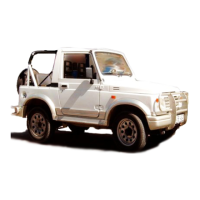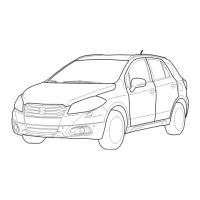Fuel Filler Cap
The fuel tank filler neck has a pressure-vacuum
cap.
A ratchet tightening device on the threaded fuel
filler cap reduces the chances of incorrect
installation, which would prevent sealing fuel
vapors.
After the gasket on fuel filler cap and the filler
neck flange contact, the ratchet produces a
loud clicking noise, indicating the seal has been
set.
This cap has pressure relief valve and vacuum
relief valve inside.
If the pressure of fuel vapor in fuel tank should
exceed that for which fuel system is designed,
the pressure relief valve opens to relieve the
pressure.
The vacuum relief valve opens to relieve the
vacuum created in fuel tank.
1. Pressure relief valve
2. Vacuum relief valve
3. Gasket
Fig. 4-2- 10
Fuel filler cap cross-section
REMOVAL AND INSTALLATION
CALJTION:
Before attempting. service of any type on
fuel system, the following cautions should
be always observed.
l
Disconnect negative cable at battery.
l
DO NOT smoke, and place “NO
SMOK-
I NG” signs near work area.
l Be sure to have
COZ
fire extinguisher
handy.
0
Wear safety glasses.
l To release fuel vapor pressure in fuel
tank, remove fuel filler cap from fuel
filler neck and then reinstall it. If
prec
sure in fuel tank is not released before-
hand, fuel in fuel tank may come out of
fuel hoses due to the pressure when they
are disconnected.
l Note that fuel hose connection varies
with each type of pipe. Be sure to
connect and clamp each hose correctly
referring to the following.
With following type pipe, fit hose as far as it reaches
pipe joint as shown.
/
Clamp securely at a position
3
to 7 mm (0.12
-
0.27 in.)
from hose end.
With following type pipe, fit hose as far as its peri-
pheral projection as shown.
\
Clamp securely at a position
3 to 7 mm (0.12
-
0.27 in.)
from hose end.
With following type pipe, fit hose es far as its bent
part as shown or till pipe is about 20 to 30 mm (0.79
-
1.18 in.) into the hose.
Clamp securely at a positior
3
to 7 mm (0.12
-
0.27
in.:
from hose end.
4-33

